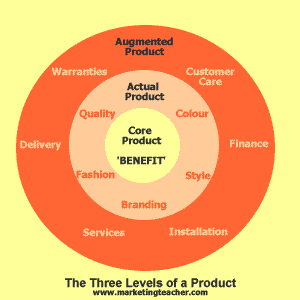Three Levels of a Product.
Consumers often think that a product is simply the physical item that he or she buys. In order to actively explore the nature of a product further, let’s consider it as three different products – the CORE product, the ACTUAL product, and finally the AUGMENTED product. This concept is known as the Three Levels of a Product.

The CORE product is NOT the tangible physical product. You can’t touch it. That’s because the core product is the BENEFIT of the product that makes it valuable to you. So with the car example, the benefit is convenience i.e. the ease at which you can go where you like, when you want to. Another core benefit is speed since you can travel around relatively quickly.
The ACTUAL product is the tangible, physical product. You can get some use out of it. Again with the car, it is the vehicle that you test drive, buy and then collect. You can touch it. The actual product is what the average person would think of under the generic banner of product.
The AUGMENTED product is the non-physical part of the product. It usually consists of lots of added value, for which you may or may not pay a premium. So when you buy a car, part of the augmented product would be the warranty, the customer service support offered by the car’s manufacturer and any after-sales service. The augmented product is an important way to tailor the core or actual product to the needs of an individual customer. The features of augmented products can be converted in to benefits for individuals.
Features and benefits of products
Features and benefits of a product are also relevant to the three levels of the product. Products tend to have a whole series of features but only a small number of benefits to the actual consumer.
Let’s look at this another way, if you buy a Nintendo console it has many features; for example you can play games alone or you can play against another opponent or two or three opponents. You can also have access to the Internet. Avatars are adaptable so you can create yourself and your friends. These are all examples of features to the consumer. However a consumer may buy it because he or she wants to stay fit and will use software and peripherals to become healthier. Becoming healthier is the benefit to the consumer.
The consistent marketer will aim to discover the consumer’s preference for benefits and will match individual features to the preference. That is why professional salespeople for example, often ask many questions whereas a novice salesperson will just tell you the features of the product.
New Product Development (NPD)
New Product Development (NPD) will take in to account the consumer’s preference for benefits over features by considering research into their needs. NPD aims to satisfy and anticipate needs. NPD delivers products which offer benefits at the core, actual and augmented levels.
NPD might offer a replacement product for a current line, it could add products to the current line, it could discover new product lines and sometimes it delivers very innovative products which the world might not have seen before.
New products are launched for all sorts of reasons. As we know from our previous lesson on the business environment, legislation i.e. changes in the law can mean that companies have to design and develop new products. An example of this was when we moved from videotape recorders to digital and DVD recorders. So products need to be modified for changing target markets.
Sometimes the company will need to increase the volume that a production plant delivers, since maybe it is not running at full capacity. An example of this would be a food manufacturer of tinned soup that has a factory which can operate 24/7, designing different derivatives of the soup in order to lower the unit cost of production. So product lines are extended, in this case the reason being is to ease operational efficiency.
Intense competitive rivalry in the market will also lead to the need for NPD. Just think about your smart phone and how quickly such products go through their product life cycles, throughout your customer life-cycle.
Change in any element of the marketing mix would influence NPD, for example there is a movement to shop online and some products need to be distributed via online retailers, and the product is adapted to make it compact and simple to deliver. NPD can be driven by many influences from changing consumer tastes to the need to adapt products and services for local or international market.
Another marketing tool for evaluating PRODUCT is the Product Life Cycle (PLC). Also see the Customer Life Cycle (CLC).
